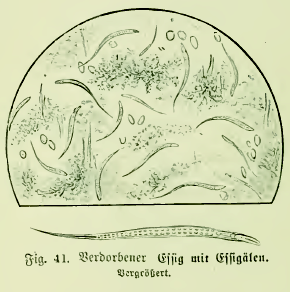Vinegar eels facts for kids
Quick facts for kids Vinegar eels |
|
|---|---|
 |
|
| Illustration of vinegar eels | |
| Scientific classification | |
| Genus: |
Turbatrix
|
| Species: |
aceti
|
| Synonyms | |
|
|
Turbatrix aceti, often called vinegar eels, are tiny, free-living nematodes. They are not really eels, but a type of microscopic worm! These creatures love to eat a special mix of bacteria and yeast. This mix is known as "mother of vinegar" and is used to make vinegar. You can sometimes find vinegar eels in vinegar that hasn't been filtered. A scientist named Pierre Borel first discovered them way back in 1656.
Contents
What Are Vinegar Eels?
Vinegar eels are very small, worm-like animals. They belong to a group called nematodes, which are common roundworms. These tiny worms are so small you usually need a microscope to see them clearly. They get their name because they are often found in unfiltered vinegar.
Where Do They Live?
Vinegar eels thrive in the "mother of vinegar." This is a slimy, jelly-like substance made of bacteria and yeast. It forms naturally when alcohol ferments into vinegar. The eels feed on these tiny microbes. This is why they are usually found in homemade or unfiltered vinegars.
How Do They Survive Extreme Conditions?
Vinegar eels are super tough! They can live in very acidic or very alkaline environments. Think about how sour vinegar is – that's very acidic! Scientists measure acidity and alkalinity using something called pH. A low pH means it's acidic, and a high pH means it's alkaline. Vinegar eels can survive in a huge range, from pH 1.6 (very acidic, like stomach acid) all the way to pH 11 (very alkaline, like soapy water). This wide tolerance makes them unique among living creatures.
Why Are They Important?
Vinegar eels might be tiny, but they play a few interesting roles!
Tiny Food for Baby Fish
Many people who raise fish use vinegar eels as food for their baby fish, called "fry." These tiny worms are a great source of live food, similar to other small worms like microworms. They help baby fish grow strong and healthy.
Are They Harmful to Humans?
Even though they live in something we eat, vinegar eels are completely harmless to humans. They are not parasitic, meaning they don't live inside other animals or people to cause harm. However, most people don't want to see tiny worms floating in their food! Because of this, many countries, like the United States, don't allow vinegar with live eels to be sold. To make sure vinegar is clean and clear, companies usually filter it. They also often pasteurize it, which means heating it to kill any tiny living things. This process removes the "mother of vinegar" culture that the eels need to survive.
Working Together: Collective Waves
When many vinegar eels gather close together, they do something amazing! They start to move in sync, wiggling their bodies at the same time. This synchronized movement creates a kind of "collective wave." It's like a tiny, living ripple effect! Scientists are still studying why they do this and what benefits it might have for them.
See also
 In Spanish: Gusano del vinagre para niños
In Spanish: Gusano del vinagre para niños

